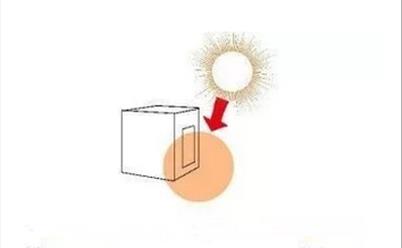
Renderwow
Light is a sphere, whether it's a fluorescent lamp, tube lamp, or the light from a square lamp, the light will eventually form a sphere. Projection forms a circle on the plane, even in the dark at noon, a circular light can be seen.


That is to say, in addition to being exposed to intense light similar to direct sunlight, or in the case of total darkness, round light adheres to all objects.
Do you know why the corner of room is in the dark? And on the side of wall is darker than any other places? Acturally, many people always ignore it. Let's take a look at the lighting characteristics of all sides of the room:

1.Unless otherwise specified, the ceiling is darker than the floor, even if there is a light source, it will be darker than the floor.
2. the face that becomes the light source is the darkest of the six faces, the light source and halo parts are dazzling, it's easy to mistake it for the brightest, but the opposite is true, except for the slightly dim light, the contrast is also low.
3. the area adjacent to the light source is brighter, but there are often shadows on the edges of intersections.
4. If you want to do interior designer, you need to draw the ground which will be covered light the most, so you could do a good comparison.
5. The side of wall without a light source; If you will not see the ground , please highlight it; If there is a ground, you can completely ignore it.
6. when the sun is low in the morning or evening, or if the room is relatively narrow, the farthest side from the light source will shine.
When the characteristics of indoor light are known, next, we begin to introduce the idea of lighting indoors in different environments.
Morning interior

Think of the photosphere as [half buried in the ground], as shown in the figure above, so indoor light is basically done. Minimize the grey type, simply finish coloring.

Indoor in daytime (summer)

When the sun rises, the light bulb coming in through the window will retreat, when the sunshine is strong, there will be a sudden darkening around the light source, a strong halo will occur, and it's worth noting that during the day there is almost always a halo at the bottom of the window.

The evening interior

In the evening, as the light source decreases, a light bulb passing through the window will reach the depth of the room, the most important thing is to reduce the contrast, so the whole can be a gray or a gradient, gradient direction is not vertical from top to bottom, it's an oblique angle. Make as few solid colors as possible to fill the whole surface.

Night (Lighting) Indoor

Electric lamps are basically designed as light spheres for the convenience of life, located in the lower central part of the room. At this time the window darkens, like a mirror, it can reflect the lights and all kinds of things in the room.

In the evening (moonlight) room

The light bulb will be very small in the moonlight, night scenery can basically be regarded as the feeling of small globules scattered in the darkness, because of the mechanism of human eyes, the things ahead will be a little brighter, it's a challenge to compete for how bold it is to subtract stereo information from solid colors, if properly handled, the picture will be better.

Above is the idea of lighting indoors in different environments.